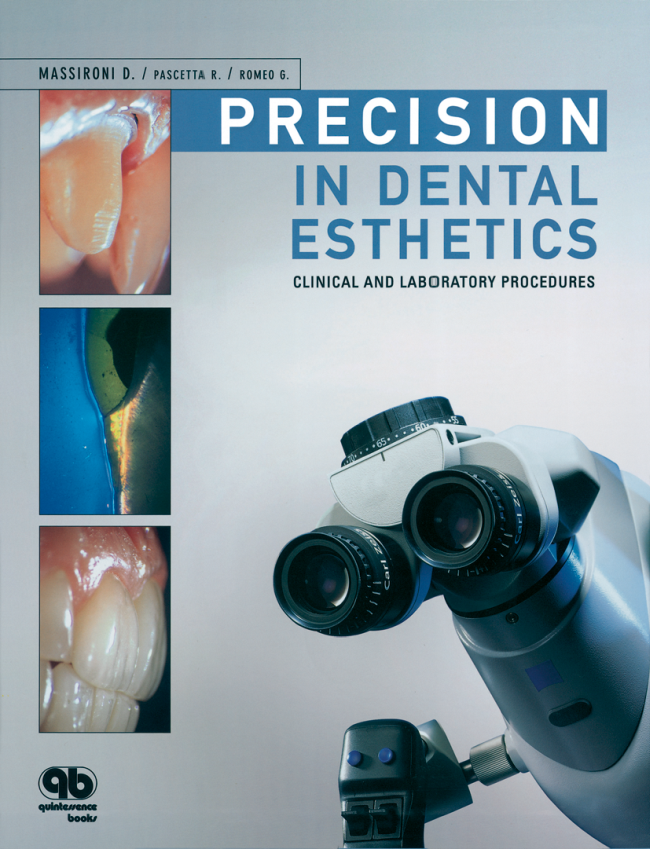International Journal of Oral Implantology, 4/2015
PubMed-ID: 26669549Seiten: 397-403, Sprache: EnglischRotundo, Roberto / Nieri, Michele / Bonaccini, Daniele / Mori, Massimiliano / Lamberti, Elena / Massironi, Domenico / Giachetti, Luca / Franchi, Lorenzo / Venezia, Piero / Cavalcanti, Raffaele / Bondi, Elena / Farneti, Mauro / Pinchi, Vilma / Buti, JacopoPurpose: To propose a method to measure the esthetics of the smile and to report its validation by means of an intra-rater and inter-rater agreement analysis.
Materials and methods: Ten variables were chosen as determinants for the esthetics of a smile: smile line and facial midline, tooth alignment, tooth deformity, tooth dischromy, gingival dischromy, gingival recession, gingival excess, gingival scars and diastema/missing papillae. One examiner consecutively selected seventy smile pictures, which were in the frontal view. Ten examiners, with different levels of clinical experience and specialties, applied the proposed assessment method twice on the selected pictures, independently and blindly. Intraclass correlation coefficient (ICC) and Fleiss' kappa) statistics were performed to analyse the intra-rater and inter-rater agreement.
Results: Considering the cumulative assessment of the Smile Esthetic Index (SEI), the ICC value for the inter-rater agreement of the 10 examiners was 0.62 (95% CI: 0.51 to 0.72), representing a substantial agreement. Intra-rater agreement ranged from 0.86 to 0.99. Inter-rater agreement (Fleiss' kappa statistics) calculated for each variable ranged from 0.17 to 0.75.
Conclusion: The SEI was a reproducible method, to assess the esthetic component of the smile, useful for the diagnostic phase and for setting appropriate treatment plans.
Schlagwörter: classification, diagnosis, esthetics, index, smile
Quintessence International, 4/2010
PubMed-ID: 20305862Seiten: 285-293, Sprache: EnglischAgliardi, Enrico / Clericò, Matteo / Ciancio, Paolo / Massironi, DomenicoObjectives: This study aimed to evaluate the long-term prognosis of immediately loaded fixed full prostheses for the treatment of edentulous patients with extreme bone atrophy in the posterior mandibular region.
Material and Methods: Twenty-four edentulous patients with atrophic posterior mandibles were treated by means of a complete prosthesis sustained by both axial and tilted fixtures. The insertion of tilted implants was carefully planned by means of computed tomography scan analysis and measuring width and height of residual bone. Implant type, length, and diameter were chosen, as well as implant angulation, according to the All-on-Four protocol and avoiding the course of the mandibular nerve. The prosthesis was delivered no later than 2 days after implant surgery. Implant survival and prosthesis success were assessed clinically and radiographically up to 42 months of follow-up. Measurement of peri-implant bone loss was based on periapical radiographs after 12 months of loading.
Results: All implants survived and all prostheses were successful at the time of this study reporting. The mean follow-up was 30.1 months with a range of 14 to 44 months. The average peri-implant bone loss was 0.85 mm after 12 months (0.8 mm for tilted implants and 0.9 mm for axial implants). No significant difference in marginal bone loss was observed between axial and tilted implants.
Conclusions: The immediate rehabilitation of patients with extreme atrophic mandibles can be successful with careful planning and particular attention during the surgical placement of the implants, as shown by the excellent outcomes of the present study.
Schlagwörter: endosseous implants, extreme atrophy, immediate loading, mandible, tilted implants
QZ - Quintessenz Zahntechnik, 2/2010
BasicsSeiten: 158-173, Sprache: DeutschMassironi, Domenico / Pascetta, Romeo / Romeo, GiuseppeDie Behandlung prothetischer Fälle umfasst verschiedene Phasen und Arbeitsschritte, bei denen sich sowohl Zahnarzt als auch Zahntechniker große Mühe geben müssen, wollen sie das in der Planung definierte Ziel erreichen. Die Bedeutung dieser initialen Phase der Behandlungsplanung kann nicht hoch genug eingeschätzt werden. Der vorliegende Beitrag, der eine Analyse der wichtigsten prothetischen Planungsschritte im prothetischen Team umfasst, ist eine überarbeitete Zusammenfassung des ersten Kapitels aus dem im Quintessenz Verlag erschienenen Lehrbuch: "Präzision dentaler Ästhetik. Klinische und zahntechnische Aspekte" von Domenico Massironi, Romeo Pascetta und Giuseppe Romeo.
Schlagwörter: Zahntechnik interdisziplinär, Prothetik, Anamnese, Behandlungsplanung, Kommunikation
QZ - Quintessenz Zahntechnik, 8/2009
BasicsSeiten: 984-1000, Sprache: DeutschMassironi, Domenico / Pascetta, Romeo / Romeo, GiuseppeUm eine optimal sitzende und funktionell erstklassige prothetische Versorgung gewährleisten zu können, sind auch heute noch Abformung und Modell die zentralen Kommunikationsmittel zwischen Zahnarzt und Zahntechniker. Im vorliegenden Artikel wird zunächst die schrittweise und korrekte Herstellung eines Meistermodells beschrieben, das als Arbeitsmodell bei der Herstellung metallkeramischer Versorgungen dient, deren Herstellung ebenfalls ausführlich behandelt wird.
Schlagwörter: Metallkeramik, Modellherstellung, Modellsysteme, Gießen, Keramikschichtung
QZ - Quintessenz Zahntechnik, 6/2007
Case ReportSeiten: 684-692, Sprache: DeutschMassironi, Domenico / Pascetta, Romeo / Romeo, GiuseppeIn diesem Artikel wird kurz der Inhalt des im Nachhinein veröffentlichten Buches "Präzision in dentaler Ästhetik"12 zusammengefasst, um die wichtigsten darin behandelten Aspekte und Thematiken aufzuzeigen, die Ergebnis der engen Zusammenarbeit zwischen einem Behandler und zwei Zahntechnikern sind. Sämtliche klinischen und labortechnischen Arbeitsschritte im Hinblick auf Ästhetik und Präzision, die den Autoren besonders am Herzen liegen, werden unter Berücksichtigung der wissenschaftlichen Grundlagen, doch in einem klinisch und vorwiegend praktischem Kontext analysiert. Dabei werden den Akteuren dieser Disziplin für die tägliche Praxis nützliche Hinweise und Mittel geliefert, um die unzähligen Probleme einer prothetischen Versorgung zu lösen.
Schlagwörter: Restaurationsteam, Stereomikroskop, Verblendung, prothetische Rehabilitation






